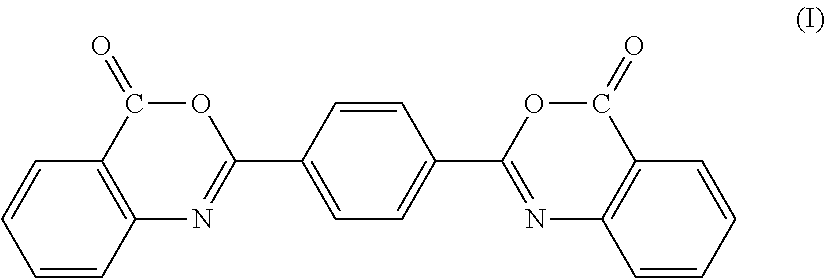Polyamide composition containing electrically conductive carbon
a technology of polyamide and carbon, applied in the direction of conductive materials, non-conductive materials with dispersed conductive materials, carbon-silicon compound conductors, etc., can solve the problems of difficult to prevent, easy to damage electronic components, and often occur anisotropic effects,
- Summary
- Abstract
- Description
- Claims
- Application Information
AI Technical Summary
Benefits of technology
Problems solved by technology
Method used
Image
Examples
example 1
Preparative Example 1
7-(4,5-Dihydrooxazol-2-yl)-2-phenylbenzo[d][1,3]oxazin-4-one (BFK 1) according to L. Jakisch et al., Journal of Polymer Science: Part A: Polymer Chemistry 2003; 41(5): 655-667
[0118]36.2 g (200 mmol) of 2-aminoterephthalic acid were added to a solution of 28.2 g (200 mmol) of benzoyl chloride in 500 ml of dried tetrahydrofuran which had been cooled to 0-10° C. 20.2 g of triethylamine (200 mmol) were then added dropwise over a period of 30 minutes. After stirring at room temperature for another 1 hour, the solvent was distilled off under reduced pressure. The solid residue was suspended in 400 ml of water, filtered off and washed with water. After thorough drying, this intermediate was stirred with 300 ml of thionyl chloride at 60° C. until no more bubbles formed. The excess of thionyl chloride was then distilled under reduced pressure. The residue was dissolved in 200 ml of toluene under reflux. After cooling and precipitation with 1000 ml of n-hexane, the interm...
example 2
Preparative Example 2
2,2′-(1,4-Phenylene)bis(4H-3,1-benzoxazin-4-one) (BFK 2) according to Inata et al.; Journal of Applied Polymer Science 1986; 32(4): 4581-4594
[0121]The synthesis was carried out in a 500 ml three-neck flask provided with magnetic stirrer, reflux condenser, drying tube and dropping funnel. 2.03 g (10 mmol) of terephthaloyl chloride were dissolved in 50 ml of N,N-dimethylacetamide and 2.74 g (20 mmol) of 2-aminobenzoic acid as powder were added thereto while stirring. A mixture of 2.02 g (20 mmol) of triethylamine and 5 ml of N,N-dimethylacetamide was subsequently slowly added dropwise at room temperature. After stirring at room temperature for 1 hour, 200 ml of water were added and the precipitate formed was filtered off with suction, washed with water and dried at 80° C. under reduced pressure. The product was then heated in 50 ml of acetic anhydride under reflux for 2 hours. After cooling, the precipitate formed was filtered off with suction and washed with acet...
example 3
Preparative Example 3
2-(4-Oxazolinyl)-4H-3,1-benzoazin-4-one (BFK3)
[0122]The compound was prepared by the method described by L. Jakisch et al.; Macromolecular Symposia 2000; 149: 237-243.
PUM
| Property | Measurement | Unit |
|---|---|---|
| diameter | aaaaa | aaaaa |
| diameter | aaaaa | aaaaa |
| diameter | aaaaa | aaaaa |
Abstract
Description
Claims
Application Information
 Login to View More
Login to View More - R&D
- Intellectual Property
- Life Sciences
- Materials
- Tech Scout
- Unparalleled Data Quality
- Higher Quality Content
- 60% Fewer Hallucinations
Browse by: Latest US Patents, China's latest patents, Technical Efficacy Thesaurus, Application Domain, Technology Topic, Popular Technical Reports.
© 2025 PatSnap. All rights reserved.Legal|Privacy policy|Modern Slavery Act Transparency Statement|Sitemap|About US| Contact US: help@patsnap.com



